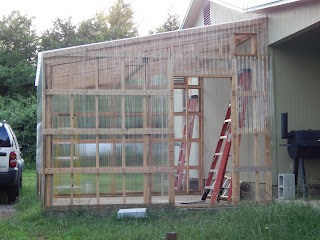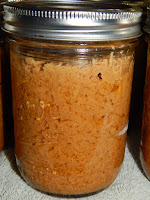As some of you are probably aware, I've been teaching a ham radio and survival communications class to some of the folks from my local, small town community. This has really been a fun time. It's caused me to dig a little deeper about radio information than I normally do, and it's given me the opportunity, when I didn't have a clue what the answer was, to refine my lying skills. Just kidding, of course. Kinda.
This is a group of adults, with one 16 year old young adult, two ladies and about 15 men. It's also a very diverse group with various occupations and perspectives about life. But one thing that most of us agree with in this group is that something is coming that is not necessarily going to be good. And that is interesting, because most of the people in this class I did not know before it started.
But back to the story. Last Tuesday evening I got to do show and tell. If you've forgotten what show and tell is, it's that major event when little kids bring something from home to school and talk about it. You know, show and tell. Well, I brought my little Jeep Liberty loaded down with assorted radio toys. My Jeep already has three antennas permanently mounted on it. One of them is the AM/FM radio antenna which gets very little use. Another one is a four foot CB antenna and the other one is a 40" VHF/UHF antenna. The last two are mounted on the rear of the vehicle where the hatch opens, on opposite sides.
I disconnected my CB and my VHF/UHF radios in the car, then rerouted the coax to the back of the vehicle, and used these two antennas during show and tell. But, I need power for these radios, so I took about a 10' piece of 14/2 speaker wire, put a power pole connector on each end, connected one end inside the vehicle to the power source where the original two radios were connected. I routed that power extension out the open hatch in the back. Now we have power at the rear of the vehicle, a CB antenna and a VHF/UHF antenna.
I borrowed a little individual student desk from the church hall where we've been holding our classes, and set up an HF radio and a VHF/UHF radio on this little desk. But I didn't want to use my CB antenna because it is rather limited. As part of the show and tell demonstration, I removed the 48" CB antenna and replaced it with the world famous 102" stainless steel whip antenna. This is the antenna that all others are judged by. The 102 is the one that the really cool cowboys have on their pick up trucks with their CB radios, and now, I was really cool, too. Why the 102? It's by far the best mobile CB antenna made, not the most expensive, but the best performing. So why doesn't everybody use it, you ask? Pray tell, not everyone can handle being cool. Or, maybe realistically, it's because it's 102" long, and it just doesn't fit in everybody's garage door. But the primary reason I used it is because CB is actually the 11 meter HF band, which is right between the 10 and 12 meter bands. With a good tuner, you can tune down to the 20 and 40 meter bands.
Well, we listened for a while on some of the HF bands, and we also listened to some shortwave frequencies. The radio we used to do this with is an ICOM IC-718 accompanied with a LDG IT-100 tuner. I purchased this radio used a couple of days earlier, cleaned it up, reprogrammed it, made some modifications and now it's ready to go. It's a no frills radio with solid performance. The LDG tuner is an excellent compliment to the radio.
Is the 102 the perfect antenna? It is for the CB bands, and it met the needs that evening for show and tell. But you ask, what about the
other radio? Well, the other radio was a VHF/UHF, commonly called a dual band radio. It was connected to the same power supply that ran from the front to the back of the vehicle. It was connected to my mobile antenna that I use everyday, which is a Comet CA 2x4 SR. It's not your everyday ham radio antenna, but it works great on the ham frequencies, and it also works great on the search and rescue frequencies which is what the SR stands for. The radio I was using is the same type I use everyday in my vehicle, but I didn't want to disconnect it, so I used my back up storage radio, which is also and Anytone AT-5888UV. It is not a ham radio, it is a commercial radio that works fine on the ham frequencies and the search and rescue frequencies. We did make contacts with a couple of outside stations and it was fun.
On hand that evening I also brought a VHF/UHF magnet mount antenna. This is the antenna that Fern and I first used on our vehicles. It's a good solid mobile antenna that is also made by Comet, model M-24. Due to time restraints, I did not hook up this antenna, but I did bring a hand held Wouxun dual band VHF/UHF and showed the group how you can connect this radio to the external antenna with an adapter, using what is called a
battery eliminator that plugs into a cigar plug or power port. With a good microphone attached, and a little Velcro, you now have a solid performing, mobile, 5 watt, VHF/UHF, commercial radio that works on the ham bands, and also the search and rescue frequencies. This is the set up that Fern and I used when we started getting serious about longer distance communication. This set up worked quite well and it would still work quite well. For under $100 one can have an outside the vehicle antenna, which is a must for reliable distance communications, a radio, power supply, and Wa-la! you have communications. There are thousands of ham radio operators that use this type of set up for VHF/UHF. If you get the inclination, you can disconnect the radio from the outside antenna, remove the battery eliminator, insert the original battery, attach the original antenna, and you can now take your hand held radio for a walk. Life is good.
 The overall demonstration that night went well. Sitting in a classroom and talking about something is one thing, but seeing it right there in front of you is the best teacher. I'm happy to say that show and tell went well. If some of the language in this article seems a little foreign to you, may I recommend you scoot over to the right hand side of this blog, and up toward the top you will find Frank's Radio Communications. Inside Frank's Radio Communications you will find many articles about radio communications. Some are about ham radio, but there are also articles about CB, GMRS, scanners, shortwave and other radio articles in general.
The overall demonstration that night went well. Sitting in a classroom and talking about something is one thing, but seeing it right there in front of you is the best teacher. I'm happy to say that show and tell went well. If some of the language in this article seems a little foreign to you, may I recommend you scoot over to the right hand side of this blog, and up toward the top you will find Frank's Radio Communications. Inside Frank's Radio Communications you will find many articles about radio communications. Some are about ham radio, but there are also articles about CB, GMRS, scanners, shortwave and other radio articles in general.Ladies and gentlemen, teaching this class has been lots of fun. It's been very eye opening. If you want to learn how to communicate, you can do it too. Here in the near future you might want to have a different way to communicate besides what you depend on today. There is thunder just over the horizon. I would like to be able to quote Ronald Regan, but I can't, so I will paraphrase him. When the man from the government shows up at your door and says he is here to help, turn around and run. Ladies and gentlemen, that man is at the door. Don't get on the bus.
We'll talk more later, Frank


























































